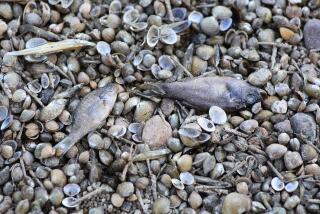Eastern Sierra’s Lower Owens River is ripe for a recreational rebirth
- Share via
LONE PINE, Calif. — An Inyo County official and an environmental activist stepped into wobbly kayaks on Saturday to gauge the prospects of developing a “paddling experience” that would float people down the eastern Sierra Nevada’s Lower Owens River.
To Larry Freilich, Inyo County Water Department mitigation manager, and George Wolfe, founder of L.A. River Expeditions, the Lower Owens’ lazy loops, oxbows and wetlands — habitat for elk, bobcats and waterfowl — and rugged, wide-open scenery are reason enough to make such voyages worthwhile.
But there is another reason: the river is linked to the century-old Los Angeles Aqueduct system, which, powered by gravity alone as it taps the snows of the Sierra Nevada, nurtures the metropolis 200 miles to the south.
Trips down the Lower Owens would provide a personal understanding of how Sierra snowmelt nourishes a haven for wildlife and contributes to the water budget of a distant city of nearly 4 million people.
Wolfe, who pioneered kayaking trips down the L.A. River, liked what he saw. Rounding a bend in the river, about 20 feet wide and 3 to 6 feet deep, he said, “It’s enormously promising — and ready to use. This would not just be about boating — it would also be about water, where it comes from and how to use it sensibly.”
Freilich believes excursions could be modeled after concessions that take paying customers each summer along an arrow-straight stretch of the L.A. River’s murky blend of imported water and treated urban runoff flanked by the 101 and 405 freeways and strewn with trash.
“It could be an incredible recreation resource,” Freilich said. “Of course, we’ll need a partnership with the Los Angeles Department of Water and Power, which owns the water and the land that surrounds it.”
DWP officials were not available for comment.
The Lower Owens is a product of the largest river habitat restoration effort ever attempted in the western United States.
After the Owens River’s water was diverted into the aqueduct in 1913 there was no more for the 62-mile-long Lower Owens, much of which became a dry gulch. It also denied water to the river’s massive catch basin, Owens Lake, which evaporated into vast salt flats prone to causing choking dust storms.
After groundwater pumping by the DWP between 1970 and 1990 destroyed habitat in the Owens Valley, the DWP agreed in 1991 to restore the Lower Owens to compensate for the damage.
It took 15 years of court battles, however, before a portion of aqueduct water was redirected into the channel and the Lower Owens rippled anew.
The results were in plain sight as paddles dug into the water Saturday. Wrens and rails chattered in brambles on the river’s edge. Bass and carp lurked in the shallows.
The restoration effort, however, also left the Lower Owens overrun with cattails, cane and bulrushes. In preparation for Saturday’s tour — and more to follow — Freilich and a small army of volunteers armed with scythes created a “paddle trail” by removing the vegetation collectively known as tules from two miles of river channel.
Along for the ride was Wolfe’s wife, Thea Mercouffer, a filmmaker whose award-winning documentary, “Rock the Boat,” chronicles the fight to reclaim and renew the L.A. River as a natural resource.
“Given their mutual heartbreaking histories of abuse and renewal,” she said, “the Los Angeles River and Lower Owens River should be formally designated as sister rivers.”
More to Read
Sign up for Essential California
The most important California stories and recommendations in your inbox every morning.
You may occasionally receive promotional content from the Los Angeles Times.











